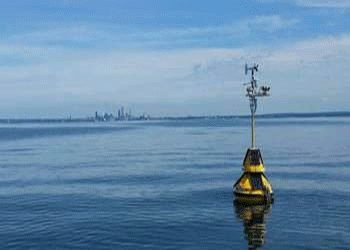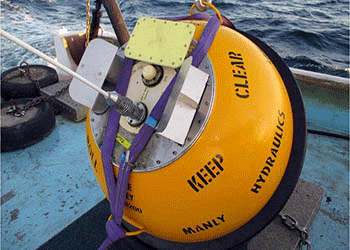Buoy marine weather South Lake Tahoe City Homewood

A buoy is a type of an object that floats in water and is used in the middle of the seas as locators or as warning points for the ships. Buoys are generally bright (fluorescent) in color. Mooring buoys are a type of buoy, to which, ships can be moored in the deep oceanic areas. A mooring buoy weighs more than the general type of buoys.
The mooring buoy is designed in a manner that there is a heavier weight located right in the bottom of the sea. This weight is like an anchor holding the buoy afloat in the water. A mooring buoy has loops or chains attached to its top that floats on the water. These chains are provided so that ships or boats can be effectively moored to them. The entire application of a mooring buoy works in such a way that the buoy is floating while the ships are moored to a very firm support without using the anchor system of halting a ship. In some parts of the world, mooring buoys are also used to moor boats and ships away from areas where coral reefs thrive.
Ships using mooring buoys to protect coral reefs do so because when the traditional types of anchors are used, they tend to dig and uproot the coral that lies deep under the water surface. This would cause a huge loss to the marine ecosystem. By using a mooring buoy, two purposes are served – the ships are moored appropriately and the loss to the marine life-forms is prevented. Such mooring buoys in coral reef areas are located mainly in Australia, Asia and also in some parts of the United States.
The shipping tankers using mooring buoys have to follow regulations set by the Oil Companies International Marine Forum (OCIMF). This is an official and voluntary association of companies that engage mainly in oil extraction and shipping across the world.
Oil tankers use mooring buoys because they are stable and easy when it comes to unloading the cargo contained in these ships. Instead of a tanker ship going to an oil rig for loading oil containers, it’s better if this procedure is carried out in the high seas so that delay in not caused in the transportation of cargo to the required areas.
A mooring buoy is being more preferred to the traditional type of anchors in today’s times. In the days to come, because of the increase in awareness towards environmental protection, the system of a mooring buoy will be the most relevant equipment in the shipping industry.
The Lateral System
The Lateral Navigation System is used to mark the most preferred and safest routes. Consisting of red and green buoys, this system marks the course of deepest water and indicates on which side of the buoy you should safely pass.
Waterway marked with lateral system navigation aids

In the Lateral System, buoys and beacons indicate the sides of the channel or route relative to a conventional direction of buoyage (usually upstream). They also mark junctions (a point where two channels meet) or bifurcations (the point where a channel divides). They can also mark a place where two tributaries meet.
Keep in mind: When navigating along the course of a channel or fairway you should be as near to the outer limit of the channel or fairway on the starboard side as is safely possible.
There are two main types of Lateral System buoys which are most familiar to boaters and are standard for international waterways:
Port-Hand Buoys
Port-Hand Buoys are green in color and mark the left side of a channel or the location of a specific danger. Port-Hand Buoys must be kept on the left-hand side of your boat when heading upstream.
Port-Hand Buoys are identified by letter(s) and odd-digit number(s), and in standard configuration, are flat on the top. In some instances, a Port-Hand Buoy may be fitted with a top mark consisting of a single green cylinder.
Lateral System Port Hand Buoys
Port-Hand Buoys may also be fitted with a green light that flashes in either a:
Starboard-Hand buoys
Starboard-Hand Buoys are red in color and mark the right side of a channel or the location of a specific danger. Starboard-Hand Buoys must be kept on the right-hand side of your boat when heading upstream.
Starboard-Hand Buoys are identified by letter(s) and even-digit number(s), and in standard configuration, are pointed on the top. If they do not have a red light they will be conical on the top.
Safe Boating Tip
Remember: Opposites attract when heading upstream! Your boat’s green sidelight will always match up with any red buoy that your boat approaches when heading upstream, and your red starboard sidelight will always pair with any green buoy that your boat approaches when heading upstream. Red/green, green/red!
Bifurcation Buoys
Part of the Lateral System, Bifurcation Buoys indicate the junction of two or more channels. You may pass on either side of these buoys when proceeding upstream but the preferred channel is indicated by the color of the topmost band:
Lateral System Bifurcation Buoys
Port-Junction Bifurcation Buoy
Port-Junction Bifurcation Buoys are green in color with a red horizontal band at the midsection. Port-Junction Buoys should be kept on the port (left) side of the vessel when navigating upstream.
Starboard-Junction Bifurcation Buoy
Starboard-Junction Bifurcation Buoys are red in color with a green horizontal band at the midsection. Starboard-Junction Buoys should be kept on the starboard (right) side of the vessel when navigating upstream.
Fairway Buoys
Fairway Buoys are used to mark the entrance to a channel, the center of a shipping channel or a safe approach to land. Operators should keep the Fairway Buoy on the left (port) side whether proceeding upstream or downstream.
Lake Tahoe weather can change in minutes. A summer’s morning and the lake is glass then by the afternoon the lake can get 5-foot waves. It starts out with cumulus clouds forming in the late morning. This usually starts on the west shore but can happen anywhere on the lake.
As the afternoon begins the clouds start to form into a Cumulonimbus cloud or thunderhead. The wind starts to pick up and small white caps begin to form. As the wind increases the white caps get larger and larger. The wavelengths are short and the height grows. You can get caught in the bottom of the trough and have water come over your bow. If you get sideways to the wave you can capsizes. This can be a life-threatening situation if you do not find shelter windward side of the shore. The Wind can shift at Tahoe and can come out of one direction and make an 180-degree turn. You think you’re on the windward side of the shore but it turns out that the wind has changed and now you on the leeward. Not a good place to be in a storm.
Water temperatures in early June can range from 42 degrees in the to 60 degrees at the end. There have been upwelling during June and in some parts of Tahoe, the water temperature can be as low a 36 degrees. Upwelling is caused by wind blowing over the water on one side of the lake. The water on the other side of the lake gets higher which pushes the warm water down and brings up the cold water on the other side. This can happen throughout the summer. That’s way people say the water was cool and then they felt a very cold spot while they were swimming or wading.